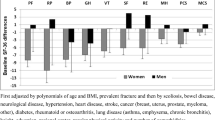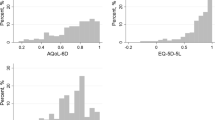Abstract
Purpose
To prospectively assess changes in health-related quality of life (HRQOL) over 10 years, by age and sex, and to compare measured within-person change to estimates of change based on cross-sectional data.
Methods
Participants in the Canadian Multicentre Osteoporosis Study completed the 36-item short form (SF-36) in 1995/1997 and 2005/2007. Mean within-person changes for domain and summary components were calculated for men and women separately, stratified by 10-year age groups. Projected changes based on published age- and sex-stratified cross-sectional data were also calculated. Mean differences between the two methods were then estimated, along with the 95 % credible intervals of the differences.
Results
Data were available for 5,569/9,423 (59.1 %) of the original cohort. Prospectively collected 10-year changes suggested that the four physically oriented domains declined in all but the youngest group of men and women, with declines in the elderly men exceeding 25 points. The four mentally oriented domains tended to improve over time, only showing substantial declines in vitality and role emotional in older women, and all four domains in older men. Cross-sectional estimates identified a similar pattern of change but with a smaller magnitude, particularly in men. Correspondence between the two methods was generally high.
Conclusions
Changes in HRQOL may be minimal over much of the life span, but physically oriented HRQOL can decline substantially after middle age. Although clinically relevant declines were more evident in prospectively collected data, differences in 10-year age increments of cross-sectional data may be a reasonable proxy for longitudinal changes, at least in those under 65 years of age. Results provide additional insight into the natural progression of HRQOL in the general population.


Similar content being viewed by others
References
Ware, J. E., Jr., Snow, K. K., Kosinski, M., & Gandek, B. (1993). SF-36 health survey: Manual and interpretation guide. Boston: The Health Institute, New England Medical Center.
Ware, J. E., Jr., Kosinski, M., & Keller, S. D. (1994). SF-36 physical and mental summary scales: A user’s manual. Boston: The Health Institute, New England Medical Center.
Ware, J. E., Jr. (2000). SF-36 health survey updated. Spine, 25(24), 3130–3139.
Garratt, A., Schmidt, L., Mackintosh, A., & Fitzpatrick, R. (2002). Quality of life assessment: Bibliographic study of patient assessed health outcome measures. British Medical Journal, 324, 1417–1421.
Hopman, W. M., Harrison, M., Coo, H., Friedberg, E., Buchanan, M., & Vandenkerkhof, E. (2009). The impact of chronic disease and increased age on physical and mental health. Chronic Diseases in Canada, 29(3), 108–116.
Bayliss, E. A., Bayliss, M. S., Ware, J. E., Jr., & Steiner, J. F. (2004). Predicting declines in physical function in persons with multiple chronic medical conditions: What we can learn from the medical problem list. Health and Quality of Life Outcomes, 2, 47–55.
Andreson, E. M., & Meyers, A. R. (2000). Health-related quality of life outcomes measures. Archives of Physical Medicine and Rehabilitation, 81(12 Suppl. 2), S30–S45.
Hemingway, H., Stafford, M., Stansfield, S., Shipley, M., & Marmot, M. (1997). Is the SF-36 a valid measure of change in population health? Results from the Whitehall II study. British Medical Journal, 315, 1273–1279.
Beaton, D. E., Hogg-Johnson, S., & Bombardier, C. (1997). Evaluating changes in health status: Reliability and responsiveness of five generic health status measures in workers with musculoskeletal disorders. Journal of Clinical Epidemiology, 50(1), 79–93.
Hopman, W. M., Towheed, T., Anastassiades, T., Tenenhouse, A., Poliquin, S., Berger, C., et al. (2000). Canadian normative data for the SF-36 health survey. Canadian Medical Association Journal, 163, 265–271.
Mein, G., Martikainen, P., Hemingway, H., Stansfield, S., & Marmot, M. (2003). Is retirement good or bad for mental and physical health functioning? Whitehall II longitudinal study of civil servants. Journal of Epidemiology and Community Health, 57(1), 46–49.
Der-Martirosian, C., Kritz-Silverstein, D., & Barret-Connor, E. (2010). Five-year stability in associations of health-related quality of life measures in community-dwelling older adults: The Rancho Bernardo Study. Quality of Life Research, 19(9), 1333–1341.
Hopman, W. M., Berger, C., Joseph, L., Towheed, T., vandenKerkhof, E., Anastassiades, T., et al. (2004). Stability of normative data for the SF-36: Results of a three-year prospective study in middle-aged Canadians. Canadian Journal of Public Health, 95(3), 387–391.
Hopman, W. M., Berger, C., Joseph, L., Towheed, T., vandenKerkhof, E., Anastassiades, T., et al. (2006). The natural progression of health-related quality of life: Results of a five-year prospective study of SF-36 in a normative population. Quality of Life Research, 15(3), 527–536.
Kreiger, N., Tenenhouse, A., Joseph, L., MacKenzie, T., Poliquin, S., Brown, J., et al. (1999). Research Notes: The Canadian Multicentre Osteoporosis Study (CaMos): Background, rationale, methods. Canadian Journal on Aging, 18, 376–387.
Rubin, D. B. (1976). Inference and missing data. Biometrika, 63(3), 581–592.
Diehr, P., Patrick, D. L., Spertus, J., Kiefe, C. I., McDonell, M., & Fihn, S. D. (2001). Transforming self-rated health and the SF-36 scales to include death and improve interpretability. Medical Care, 39(7), 670–680.
Little, R. J., D’Agostino, R., Cohen, M. L., Dickersin, K., Emerson, S. S., et al. (2012). Special Report: The prevention and treatment of missing data in clinical trials. New England Journal of Medicine, 367(14), 1355–1360.
Shih, W. J. (2002). Problems in dealing with missing data and informative censoring in clinical trials (review). Current Controlled Trials in Cardiovascular Medicine, 3(4), 7.
Wood, A. M., White, A. R., & Thompson, S. G. (2004). Are missing outcome data adequately handled? A review of published randomized controlled trials in major medical journals. Clinical Trials, 1(4), 368–376.
Kmetic, A., Joseph, L., Berger, C., & Tenenhouse, A. (2002). Multiple imputation to account for missing data in a survey: Estimating the prevalence of osteoporosis. Epidemiology, 13(4), 437–444.
Rubin, D. (1987). Multiple imputation for non-response in surveys. New York: Wiley.
Testa, M. A. (2000). Interpretation of quality of life outcomes: Issues that affect magnitude and meaning. Medical Care, 38(Suppl. II), 166–174.
Oort, F. J., Visser, M. R., & Sprangers, M. A. (2009). Formal definitions and measurement of bias and explanation bias clarify measurement and conceptual perspectives on response shift. Journal of Clinical Epidemiology, 62, 1126–1137.
Schwartz, C. E., Bode, R., Repucci, N., Becker, J., Sprangers, M. A., & Fayers, P. M. (2006). The clinical significance of adaptation to changing health: A meta-analysis of response shift. Quality of Life Research, 15(9), 1533–1550.
Wagner, A. K., Gandek, B., Aaronson, N. K., Acquadro, C., Alonzo, J., Apolone, G., et al. (1998). Cross-cultural comparisons of the content of SF-36 translations across 10 countries: Results from the IQOLA Project International Quality of Life Assessment. Journal of Clinical Epidemiology, 51(11), 925–932.
Author information
Authors and Affiliations
Consortia
Corresponding author
Additional information
Please see the “Appendix” section for CaMos Research Group members.
Appendix: CaMos Research Group
Appendix: CaMos Research Group
-
David Goltzman (co-principal investigator, McGill University), Nancy Kreiger (co-principal investigator, Toronto), Alan Tenenhouse (principal investigator emeritus, Toronto).
-
CaMos Coordinating Centre, McGill University, Montreal, Quebec: Suzanne Godmaire (research assistant), Silvia Dumont (administrative assistant), Claudie Berger (study statistician), Lisa Langsetmo (Fellow), Wei Zhou (statistician).
-
Memorial University, St. John’s Newfoundland: Carol Joyce (director), Christopher Kovacs (co-director), Emma Sheppard (coordinator).
-
Dalhousie University, Halifax, Nova Scotia: Susan Kirkland, Stephanie Kaiser (co-directors), Barbara Stanfield (coordinator).
-
Laval University, Quebec City, Quebec: Jacques P. Brown (director), Louis Bessette (co-director).
-
Queen’s University, Kingston, Ontario: Tassos Anastassiades (director), Tanveer Towheed (co-director), Wilma Hopman (research associate), Karen Rees-Milton (coordinator).
-
University of Toronto, Toronto, Ontario: Bob Josse (director), Sophie Jamal (co-director), Barbara Gardner-Bray (coordinator).
-
McMaster University, Hamilton, Ontario: Jonathan D. Adachi (director), Alexandra Papaioannou (co-director), Laura Pickard (coordinator).
-
University of Saskatchewan, Saskatoon, Saskatchewan: Wojciech P. Olszynski (director), K. Shawn Davison (co-director), Jola Thingvold (coordinator).
-
University of Calgary, Calgary, Alberta: David A. Hanley (director), Jane Allan (coordinator).
-
University British Columbia, Vancouver, British Columbia: Jerilynn C. Prior (director), Millan Patel (co-director), Brian Lentle (radiologist), Nerkeza Andjelic (coordinator).
-
McGill University, Montreal, Quebec: Elham Rahme (biostatistician), Brent Richards (research associate).
-
University of Alberta, Edmonton, Alberta: Stuart Jackson (medical physicist).
-
University of Manitoba, Winnipeg, Manitoba: William Leslie (nuclear medicine physician). CaMos is currently funded by Canadian Institutes of Health Research (CIHR), Amgen Canada Inc., Dairy Farmers of Canada, Merck Canada, Eli Lilly Canada, Novartis Canada.
Rights and permissions
About this article
Cite this article
Hopman, W.M., Berger, C., Joseph, L. et al. Prospectively measured 10-year changes in health-related quality of life and comparison with cross-sectional estimates in a population-based cohort of adult women and men. Qual Life Res 23, 2707–2721 (2014). https://doi.org/10.1007/s11136-014-0733-5
Accepted:
Published:
Issue Date:
DOI: https://doi.org/10.1007/s11136-014-0733-5




